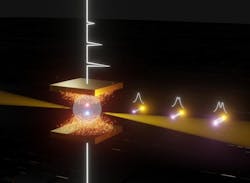Spectroscopy system manipulates polaritons, unveils quantum electrodynamics
After recently pioneering a new ultrahigh-resolution spectroscopy method, a team of researchers led by Kyoung-Duck Park, a physics professor, and Hyeongwoo Lee, a Ph.D. student at Pohang University of Science and Technology (POSTECH) in Korea, made a startling discovery when putting it to the test: they could electrically control polaritons, a.k.a. “Janus particles”—at room temperature (see video).
Polaritons possess characteristics of both photons and solid matter, which are ideal for next-gen materials. Being able to control them at room temperature can help speed advances in optical sensors, optical communications, and quantum photonic devices based on polaritons.
“During the testing phase of our device, the manipulation of polaritons unexpectedly emerged as a significant discovery,” says Park. “It underscores how the development of new devices can often lead to groundbreaking scientific breakthroughs.”
Hybrid polariton states
Park’s team created an ultrahigh-resolution electrically controlled spectroscopy method called “electric-field tip-enhanced strong coupling (e-TESC) spectroscopy” that enables stable generation of polaritons via electric field.
“We’re continuously striving to pioneer new spectroscopy systems and our latest innovation, e-TESC spectroscopy, stands as a prime example of our commitment to pushing the boundaries of scientific exploration,” says Park.
Within the strong coupling regime of exciton-plasmonic cavity systems, “the interaction between excitons and cavity photons is sufficiently strong to create hybrid polariton states,” says Park. “These polaritons can exhibit unique optical and electronic properties, which offers opportunities for applications in quantum information processing, light-matter interaction studies, and photonic device engineering.”
The team’s work is a milestone because they demonstrated the ability to electrically control polaritonic states within plasmonic cavity systems—even at room temperature. Their advance is the first known manipulation of hybrid light-matter particles at technologically relevant temperature, and it shows promise not only as a roadmap for the development of future polaritonic optoelectronic and quantum devices, but also because it provides a much deeper understanding of the veiled quantum electrodynamics within the strong coupling regime.
“One of the most remarkable aspects of our work is its scalability,” says Park. “While our research provides an in-depth understanding of the veiled quantum confined Stark effect (an optical modulation mechanism) within the strong coupling regime—a significant physical phenomenon—the platform we developed for electrically controlling polaritonic properties opens vast opportunities for creating innovative devices.”
When pioneering polaritonic devices and doing initial tests, “the foremost challenges often arise from deciphering the underlying phenomena, because the internal workings remain largely unknown,” Park says. “Fortunately, we’re collaborating with exceptional colleagues worldwide, whose insights and expertise have proven invaluable in unraveling the intricate physics at play.”
Controlling polaritonic properties opens door to innovative devices
Polaritons, which arise from the strong coupling between photons and excitons, have diverse applications in electronic devices. This includes optoelectronic devices such as polaritonic lasers and light-emitting diodes, which benefit from their low effective mass and modified dispersion relations for improved performance.
They also enable nonlinear optical devices with lower power requirements and higher speeds, quantum information processing tasks like quantum computing and communications, and sensitive sensing and detection applications. They also hold promise for energy harvesting and conversion technologies—offering opportunities for enhanced efficiency and performance in photovoltaics and thermophotovoltaics.
“Polaritons are the result of strong coupling between light and matter, and when this coupling strength surpasses a certain threshold we designate it as entering the ultrastrong coupling regime,” Park says. “The ultrastrong coupling regime also offers opportunities for engineering novel quantum states and exploring quantum phase transitions.”
By controlling the coupling strength and other parameters of the system, researchers can manipulate the energy landscape and drive the system into exotic quantum states such as squeezed or entangled states. “Our ongoing pursuit involves refining our platform to attain ultrastrong coupling and enable precise electrical control over these states,” says Park.
FURTHER READING
H. Lee et al., Phys. Rev. Lett., 132, 133001 (Mar. 25, 2024); doi:10.1103/physrevlett.132.133001.
About the Author
Sally Cole Johnson
Editor in Chief
Sally Cole Johnson, Laser Focus World’s editor in chief, is a science and technology journalist who specializes in physics and semiconductors.

